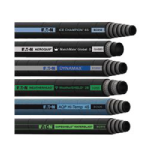Do you have a hydraulic fluid system that needs regular coupler changing? If so, you need to understand the different types of hydraulic couplers that you could use.
Over the years, manufacturers have made a diverse array of hydraulic couplings. Hydraulic quick couplers are a favorite of many businesses that need reliable couplings. They provide a durable seal while also allowing efficient changing.
The team here at Greenshields Industrial Supply put together this article on the basics of hydraulic couplings.
What Are the Types of Hydraulic Couplers?
There are dozens of hydraulic coupling designs, but six types are the most common.
Ball-Lock
Ball-lock designs are the most common and consist of a spring-loaded sleeve on the socket surrounded by a series of balls. When you insert the plug, the sleeve pushes against the bearings, creating space. When the sleeve retracts, it forces the balls into groves around the plug, creating a seal and allowing movement.
Roller-Lock
Roller-lock couplings use locking pins in slotted grooves to secure the quick couplings. When you push the plug in, the pins retract, then hold the plug in place with the retention grooves when they return. Retracting the sleeve unlocks the rollers, releasing the plug.
Pin-Lock
Pin-lock couplers utilize pins in the socket body to connect the internal valves. The pins move inwards when the plug moves and retract outwards when the plug connects. Then, shear pins secure the plug in place.
Flat-Faced
Flat-faced quick couplings are excellent for preventing hydraulic fluid leaks. They consist of two flat mating surfaces, one of which has a poppet valve (also called a mushroom valve). The poppet valve creates a seal when the two flat faces join together.
Bayonet Couplings
Bayonet couplings use a simple twist-lock mechanism to seal the lines. The plug end goes into the socket and locks in place with a twist. Plastic pneumatic devices often use these hydraulic couplers as they are light and easy to connect.
Cam-Lock
Cam-lock couplings feature two levers on the socket piece that depress to lock the plug in place. The levers close the ring in the socket, creating the seal. Cam locks are usually larger than most other kinds of couplings and require more space.
Industries Hydraulic Couplers Are Used
Engineers use hydraulic couplings to connect hydraulic systems in a diverse range of heavy-duty machines and equipment. The following industries make frequent use of hydraulic couplings:
● Construction. Various construction equipment, such as jackhammers, excavators, and bulldozers, use hydraulic couplings to regulate fluid pressure. Hydraulic tools and equipment help move heavy objects and loads.
● Automotive. Automotive companies also use hydraulics in cars. Your brakes, motors, and pumps all use a series of hydraulic lines to provide pressure.
● Aerospace. Aerospace firms also use hydraulic couplings when manufacturing airplanes and aviation equipment. For example, airplane landing gear and wing flaps use hydraulic systems to move.
● Entertainment. Hydraulic systems are also common for entertainment purposes. For example, hydraulic couplings are an integral part of roller coasters and feature in several amusement park rides.
The versatility of hydraulic systems means that they are relatively common across many industries. They can produce an incredible amount of force, so you can find them in virtually any industry that deals with heavy machinery.
Understanding Hydraulic Couplers’ Connection
Hydraulic couplings connect the various parts of hydraulic systems. The ideal hydraulic coupling depends on your hydraulic system fluid’s specific temperature, corrosivity, and viscosity.
Hydraulic couplings come in several designs, but they all share two parts: a socket and a plug. The plug and socket connect to create an airtight seal that maintains fluid pressure and prevents leaking.
Couplings also can either be valved or unvalved.
· Valved couplings content shutoff valves that prevent leakage when the lines disconnect.
· Unvalved couplings contain no valves and lower pressure loss, but they do not have any mechanism to prevent disconnect leakage.
Coupling material is also an important consideration. Common coupling materials include:
· Brass
· Copper
· Aluminum
· Stainless steel
· Plastic
· Carbon steel.
Metal couplers are more durable, but plastic components work for systems with lower pressure and temperature requirements.
Hydraulic Couplers Supply in Greenshields
Couplings are a crucial part of your hydraulic system. The quality of couplings determines how well the fluid system functions. To maintain the optimal performance of hydraulic systems, you should not compromise on coupling quality.
Greenshields offers high-quality hydraulic couplings for various fluid, gas, tool assembly, and diagnostics equipment. Feel free to browse our catalog or call us at (425) 259-0111 if you have any questions about hydraulic couplers.







